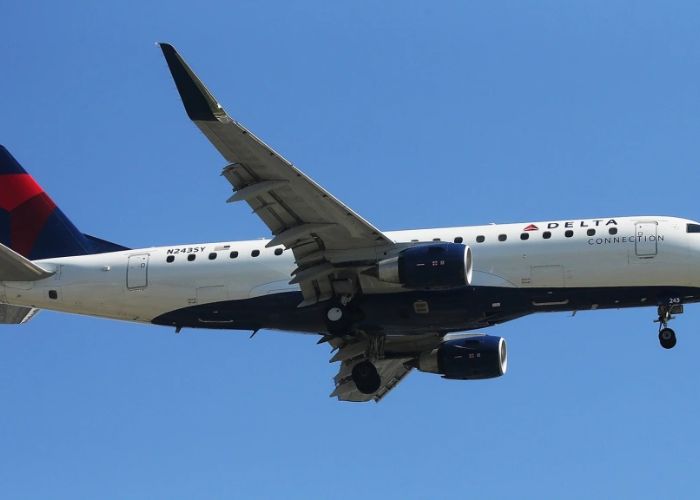Last week, a scary accident happened on a Delta flight from Atlanta to Fort Lauderdale when the cabin pressure dropped. People were hurt and had to quickly find oxygen masks. Read below about “Delta Flight Cabin Pressure Fails- Passengers Left Injured Mid-Flight”.
As a travel writer with a lot of experience who has flown a lot for work and for fun, this kind of technical failure is one of my worst fears come true. I was on a flight years ago that went through fast cabin depressurization, and I can say from personal experience how scary it can be for everyone on board.
This post will give you an outline of what happened on the Delta flight, explain how cabin pressurization works on planes, and give you safety tips from a professional in case you ever find yourself in a similar situation at 30,000 feet.
Table of Contents
What Happened on Delta Flight 2353?
On Wednesday, July 13, 2022, Delta flight 2353 was on its way from Hartsfield-Jackson Atlanta International Airport to Fort Lauderdale-Hollywood International Airport. About an hour before arriving in Fort Lauderdale, the cabin lost pressure, which made oxygen masks go off inside.
Passengers say that the oxygen masks came down from the ceiling after the cabin altitude warning went off to let everyone know that the air pressure had dropped. People said they heard a loud noise, felt pain and pressure in their ears, and saw mist coming from the gas masks.
A lack of oxygen caused several people to lose consciousness. Nine people were taken to the hospital after the plane had to make a quick stop in Fort Lauderdale. Most of the injuries were bumps and bruises from the fast fall and emergency landing.
How Airplane Cabin Pressurization Works
Pressure is built up inside airplane cabins so that people can breathe properly at high altitudes. The cabin pressurization keeps the air pressure inside the plane at a more reasonable level, which is about 5,000 to 8,000 feet above sea level.
High up in the sky, the thin, cold air is pushed down and heated by the jet engines, which bring air into the cabin. The forced air is then sent through the cabin so that everyone can breathe safely. The plane’s pressurization system carefully checks and controls the air inside the cabin.
At high altitudes, if there is a problem with the pressurization system, the cabin can lose air very quickly. When this happens, oxygen masks will automatically drop from the ceiling and give passengers and workers oxygen until the plane can descend to a safe level of air where they can breathe.
Causes of Cabin Depressurization

Loss of air pressure during a flight could be caused by a few things:
- Mechanical failure: If there are problems with the plane’s pressurization system, the pressure can drop quickly. Some examples are broken valves or lines that have burst.
- Damage to the structure: Any cracks, holes, or damage to the body or windows of the plane can do this too. Metal fatigue or damage by mistake could be to blame.
- Depressurization can also happen if a cabin door or seal doesn’t close properly or fails in the middle of the journey.
The FAA and NTSB are still looking into what went wrong with Delta flight 2353. But some kind of pressurization problem let the cabin air get too high, which is why oxygen masks were needed.
My Firsthand Experience with Cabin Depressurization
A few years ago, I was on a trip from New York to San Francisco across the country. At about 35,000 feet, the cabin quickly lost pressure. Like the people on the Delta flight, I heard a loud noise and then the gas masks fell down.
The plane quickly and immediately went down to about 10,000 feet, where the air was thick enough that people could breathe without extra oxygen. We had to put on the gas masks until we got to a lower elevation. I remember how badly the pressure changes hurt my ears because they happened so fast.
As soon as we were at a safer level, the pilot came on over the intercom to say that there had been a problem with a machine that caused the cabin pressure to drop. We were being sent to the closest airport to make an emergency landing.
Even though it was scary at the time, the team did everything right to make sure we got down safely. Everyone stayed awake thanks to the breathing masks as they went down the steep slope. The pilot kept in touch with us to keep us as calm and up to date as possible.
Tips for Travelers in Case of Cabin Depressurization
As someone who has been through rapid depressurization on a trip, here are my top tips for other travelers in case they ever find themselves in an emergency:
- Pay attention to what the flight attendants say: They have been trained to handle emergencies, so do what they say right away. This means putting on your breathing mask as soon as it goes off.
- Stay as cool as you can: It can be very scary when the oxygen masks drop. But pay attention to staying calm and taking slow, deep breaths. Don’t freak out while the team works to fix the problem.
- Wear your oxygen mask: Keep your breathing mask on until the crew tells you it’s okay to take it off. This is true even if you feel fine. When you get to high elevations, oxygen levels can drop quickly.
- To help others: If you are sitting next to a child or someone who needs help, help them put on their mask right away. After that, put yours back on.
- As little as possible: once you have oxygen, stay seated and fasten your seatbelt in case the plane needs to drop quickly. Wait until the danger is over to get up.
- Ready yourself: People who fly a lot should look over the safety card and know where the gas masks are kept. This will help you act quickly if something goes wrong.
Even though cabin air loss is very uncommon, it’s good to be ready in case it does happen. It’s important to stay focused, follow the crew’s directions, and trust the plane’s systems to keep you safe.
Conclusion
I hope this summary helps you understand what happened and gives you some travel tips about the recent emergency on Delta Flight 2353. Depressurization of the cabin is very unlikely to happen, but it can. No matter what happens at 30,000 feet, everyone on board can stay safe and calm if they are ready and follow the directions. I hope you like reading “Delta Flight Cabin Pressure Fails- Passengers Left Injured Mid-Flight”.

Sophie Turner is the adventure travel writer behind AdventureTravelFam.com. With over 10 years of experience in travel writing and a Master’s degree in Tourism Management, Sophie shares her expertise in exploring unique destinations and providing family-friendly travel tips. Follow her adventures on Instagram @adventure_travelfamily.





